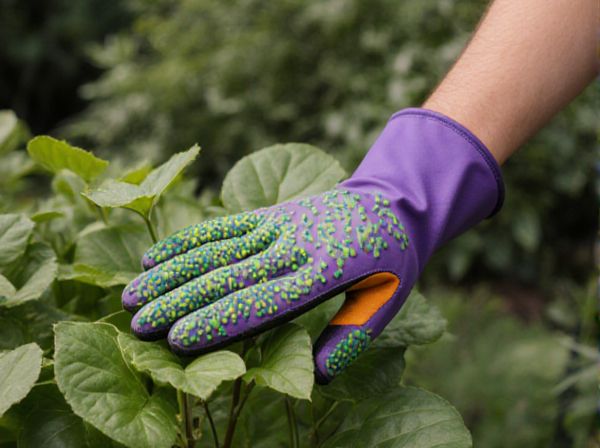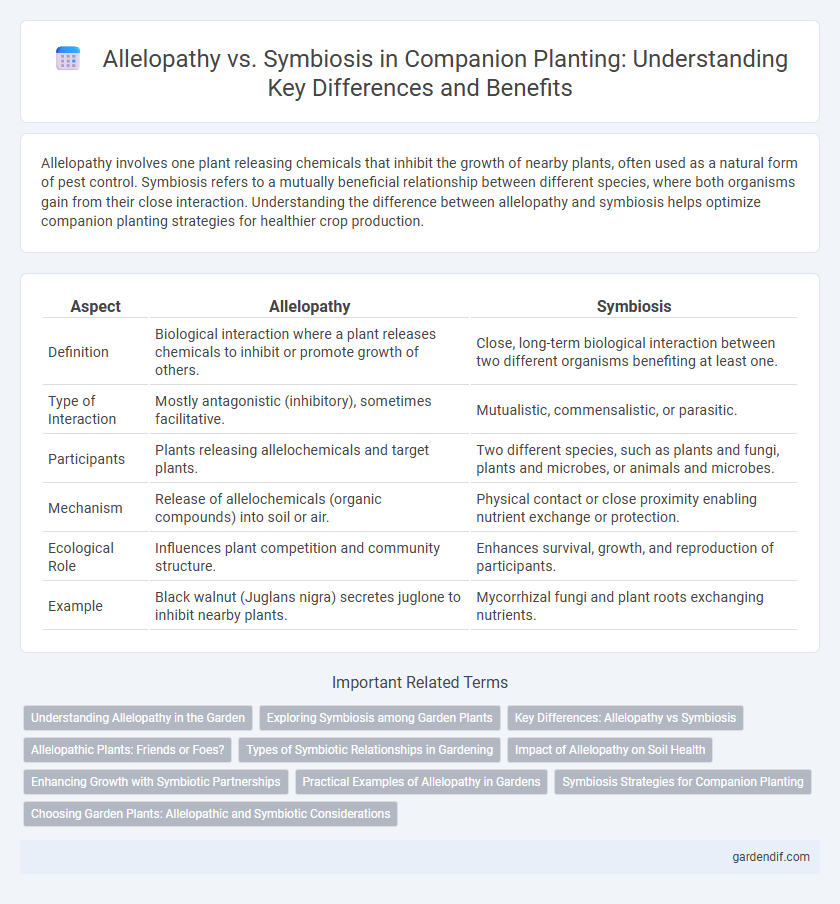
Allelopathy vs symbiosis Illustration
Allelopathy involves one plant releasing chemicals that inhibit the growth of nearby plants, often used as a natural form of pest control. Symbiosis refers to a mutually beneficial relationship between different species, where both organisms gain from their close interaction. Understanding the difference between allelopathy and symbiosis helps optimize companion planting strategies for healthier crop production.
Table of Comparison
| Aspect | Allelopathy | Symbiosis |
|---|---|---|
| Definition | Biological interaction where a plant releases chemicals to inhibit or promote growth of others. | Close, long-term biological interaction between two different organisms benefiting at least one. |
| Type of Interaction | Mostly antagonistic (inhibitory), sometimes facilitative. | Mutualistic, commensalistic, or parasitic. |
| Participants | Plants releasing allelochemicals and target plants. | Two different species, such as plants and fungi, plants and microbes, or animals and microbes. |
| Mechanism | Release of allelochemicals (organic compounds) into soil or air. | Physical contact or close proximity enabling nutrient exchange or protection. |
| Ecological Role | Influences plant competition and community structure. | Enhances survival, growth, and reproduction of participants. |
| Example | Black walnut (Juglans nigra) secretes juglone to inhibit nearby plants. | Mycorrhizal fungi and plant roots exchanging nutrients. |
Understanding Allelopathy in the Garden
Allelopathy involves plants releasing biochemical compounds that inhibit the growth of nearby species, affecting garden dynamics by suppressing weeds or competing plants. Understanding allelopathic interactions helps gardeners select compatible companions that avoid growth inhibition and promote plant health. This knowledge optimizes garden productivity by balancing plant relationships through targeted species pairing and soil management.
Exploring Symbiosis among Garden Plants
Exploring symbiosis among garden plants reveals mutually beneficial relationships that enhance growth, nutrient uptake, and pest resistance, such as nitrogen-fixing bacteria associating with legumes. Unlike allelopathy, which involves chemical inhibition between plants, symbiosis promotes cooperative interactions like mycorrhizal fungi improving water absorption for host plants. Understanding these symbiotic partnerships enables gardeners to optimize companion planting strategies that support plant health and ecosystem balance.
Key Differences: Allelopathy vs Symbiosis
Allelopathy involves the chemical inhibition of one plant by another, where compounds released into the environment suppress the growth of competing species, contrasting with symbiosis, which is a mutually beneficial relationship between different organisms. In allelopathy, the interaction is typically competitive, whereas symbiosis includes mutualism, commensalism, or parasitism with direct physical or physiological connections. The distinction lies in allelopathy's use of biochemical warfare to dominate space and resources, while symbiosis enhances survival through cooperation and resource exchange.
Allelopathic Plants: Friends or Foes?
Allelopathic plants release biochemicals that inhibit the growth of neighboring plants, influencing companion planting dynamics by suppressing potential weeds or competing species. These allelochemicals can act as natural herbicides, enhancing crop protection but may also harm beneficial companion plants if not carefully managed. Understanding allelopathy helps optimize plant pairings, ensuring healthier garden ecosystems and improved agricultural productivity.
Types of Symbiotic Relationships in Gardening
Symbiotic relationships in gardening include mutualism, commensalism, and parasitism, each playing a distinct role in plant health and growth. Mutualism benefits both plants and organisms involved, such as nitrogen-fixing bacteria in legume root nodules improving soil fertility. Commensalism allows one species to benefit without harming or helping the other, while parasitism harms the host plant, impacting crop yield and garden ecosystem balance.
Impact of Allelopathy on Soil Health
Allelopathy significantly influences soil health by releasing chemical compounds from plants that inhibit or promote the growth of neighboring species, thereby affecting nutrient cycling and microbial populations. These allelochemicals can alter soil pH, reduce beneficial microorganisms, and suppress weed growth, ultimately impacting soil biodiversity and fertility. Understanding allelopathy helps optimize companion planting strategies to enhance soil quality and sustainable crop production.
Enhancing Growth with Symbiotic Partnerships
Symbiotic partnerships enhance plant growth by facilitating nutrient exchange and improving stress resistance through mutualistic interactions. Unlike allelopathy, which involves chemical inhibition between plants, symbiosis promotes beneficial associations with fungi, bacteria, and other organisms. These relationships optimize resource uptake and increase overall plant productivity in companion planting systems.
Practical Examples of Allelopathy in Gardens
Allelopathy in gardens can be seen through black walnut trees releasing juglone, which inhibits growth of sensitive plants like tomatoes and beans nearby. Sunflowers produce allelochemicals that suppress weeds around them, reducing the need for herbicides. Crops like rye are used in cover cropping to release natural herbicidal compounds, improving soil health while controlling pest plants.
Symbiosis Strategies for Companion Planting
Symbiosis strategies in companion planting enhance plant growth by fostering mutually beneficial relationships between species, such as nitrogen-fixing legumes supporting nutrient uptake for neighboring crops. These interactions improve soil health and pest resistance, promoting sustainable garden ecosystems without reliance on chemical inputs. Effective symbiotic pairings optimize space and resource use, leading to higher yields and healthier companion plants.
Choosing Garden Plants: Allelopathic and Symbiotic Considerations
Choosing garden plants requires understanding allelopathic effects, where certain species release biochemicals that inhibit the growth of nearby plants, potentially reducing garden diversity and productivity. Symbiotic relationships, such as nitrogen-fixing legumes supporting nutrient-poor soils, enhance plant health and yield through beneficial interactions. Balancing allelopathic and symbiotic plants optimizes garden ecosystems by promoting growth while minimizing chemical competition.
Allelopathy vs symbiosis Infographic

 gardendif.com
gardendif.com